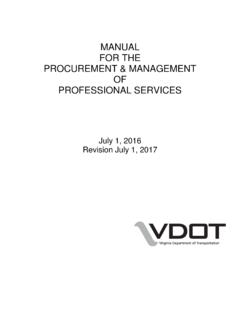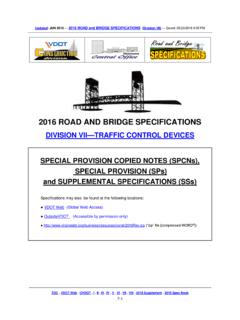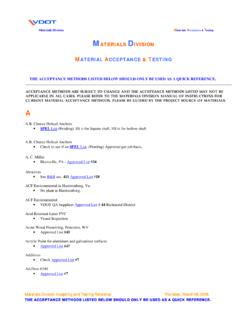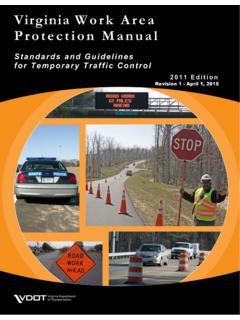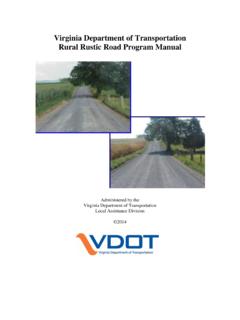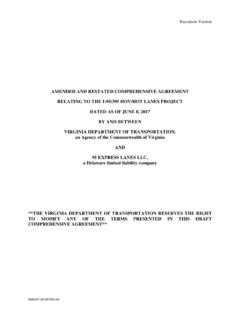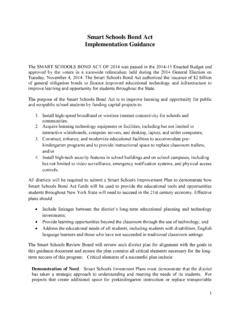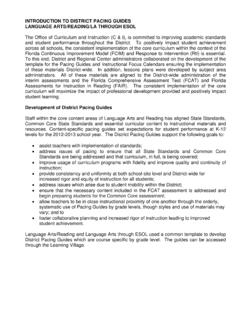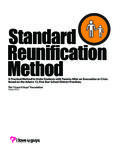Transcription of TRANSPORTATION PLANNING AND MOBILITY DIVISION
1 VIRGINIA DEPARTMENT OF TRANSPORTATION TRANSPORTATION PLANNING AND MOBILITY DIVISION INSTRUCTIONAL AND INFORMATIONAL MEMORANDUM GENERAL SUBJECT: Corridor PLANNING Studies Arterial Management Plans NUMBER: SPECIFIC SUBJECT: Process for Conducting PLANNING Studies on the Arterial Preservation Network DATE: 7/13/17 SUPERSEDES: APPROVED: Marsha Fiol State TRANSPORTATION Planner Approved _____7/13/17_____ EFFECTIVE DATE These instructions are effective as of July 13, 2017.
2 BACKGROUND VTrans, Virginia s Multimodal TRANSPORTATION plan for 2040, designates certain major highway facilities as Corridors of Statewide Significance (CoSS). In addition to the CoSS system, there are other highway facilities that are needed for statewide connectivity. These highways are functionally classified as Principal or Other Principal Arterials, and like the CoSS, are intended to accommodate long distance movements of people and goods. The viability of this system (the CoSS and the other Principal Arterials) is very important for Virginia s economy as it provides both interstate and intrastate connectivity.
3 Arterial Preservation Network The Arterial Preservation Network includes segments of selected facilities that are part of the CoSS system or are functionally classified as Principal or Other Principal Arterials. Those roadway segments selected for the Arterial Preservation Network are identified as follows: MOBILITY Preservation Segments (MPS) These are segments of arterial roadways outside of urban areas (population of 50,000 or more) that serve a critical long distance MOBILITY function where no parallel Interstate/freeway route exists.
4 VDOT s Instructional & Informational Memorandum Sheet 2 of 13 focus on these highway segments will be to preserve the MOBILITY by minimizing the delays for through traffic whenever access changes are proposed. MOBILITY Enhancement Segments (MES) These are segments of Arterial roadways inside of urbanized areas (population of 50,000 or more) where there may be opportunities to improve traffic flow without major widening. These (MES) segments often experience significant traffic growth due to the adjacent land development and travel delay due to the proliferation of entrances and traffic signals that serve adjacent land uses.
5 MES segments generally also serve multiple modes of travel. This Arterial Preservation Network is shown on a statewide map at this link. PURPOSE/SCOPE/REQUIREMENTS The primary function of the Corridors of Statewide Significance (CoSS) as well as the facilities that are classified as Principal Arterials is to serve long distance travel. In order for these corridors to continue serving this function, the ability of long distance travelers and goods to move safely and efficiently must be preserved and given priority over local access.
6 The Commonwealth TRANSPORTATION Board (CTB) has expressed the following goals for the Arterial Preservation Network: 1. Preserving the capacity on the MPS; 2. Enhancing the capacity on the MES; 3. Improving the operating efficiency; 4. Reducing the number of existing traffic signals; and 5. Minimizing the number of new traffic signals on these same facilities. The purpose of this policy is to carry out the goals of the CTB through the development of Arterial Management Plans (AMP). The AMPs will include detailed studies of the existing conditions and operations of a corridor, soliciting input from stakeholders, gaining locality input to plan innovative and cost effective solutions to improve safety, operations, and MOBILITY .
7 The procedures outlined in this document shall be used when developing AMPs and other corridor studies on the Arterial Preservation Network; however, these procedures should also be used for corridor studies on Other Principal Arterials and Minor Arterials that are not part of the Arterial Preservation Network that are important for regional connectivity and MOBILITY . Planned improvements shall minimize delay for through traffic without compromising the safety for local drivers and other road users.
8 Current access and future access points must be evaluated, planned, and designed to minimize conflict points and delay for through traffic and provide safe access to adjacent land development. This policy is intended to preserve the Commonwealth s TRANSPORTATION investments by guiding the development of Arterial Instructional & Informational Memorandum Sheet 3 of 13 Management Plans (AMP) that will allow localities and the Department to better manage and balance system performance with local access needs.
9 The Commonwealth TRANSPORTATION Board has approved a Process for Studying Corridors of Statewide Significance (CTB Policy on CoSS - page 3-116). The CTB s policy is the guidance document for corridor studies on the Corridors of Statewide Significance (COSS) and developing Corridor Master Plans for the COSS. This IIM is intended to give further instructions for the development of AMPs and other corridor studies on the Arterial Preservation Network. The following documents contain instructions and guidance on various elements that may be incorporated in the AMPs and other corridor studies: Appendix A of the Road Design Manual with emphasis on laying the foundation for Context Sensitive Solutions (CSS) - Common Sense Engineering (CSE) and Context Sensitive Solutions to TRANSPORTATION Challenges (IIM-LD-235) and Practical Design Flexibility in the Project Development Process - Fundamentals of Common Sense Engineering (IIM-LD-255).
10 Appendix F of the Road Design Manual (access management, intersections, entrances, and crossovers) Requirements for Signal Justification Reports (SJRs) For New and Reconstructed Signals (IIM-TE-387) The Manual on Uniform Traffic Control Devices (MUTCD) and the Virginia Supplement to the MUTCD. When Main Street Is a Highway: Addressing Conflicts between Land Use and TRANSPORTATION (VTRC Report 17-R13) December 2016, Kayleigh M. Roy and Peter B. Ohlms Improving Collaboration and Consensus Building in the Coordination of Access Management and Land Use in Corridor PLANNING (VTRC Report 15-R20) June 2015, Roger W.


